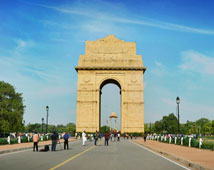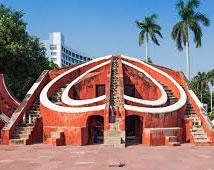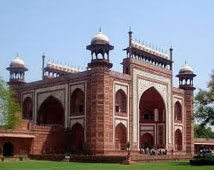
The first city of Delhi, Lal Kot was founded by the Tomar ruler Anangpal, in the 11th century. It was extended to Qila Rai Pithora by King Vigraharaja IV (Circa 1153-64). Qutbuddin Aibak became Delhi's first Sultan in 1206 and laid the foundations of the Qutb Minar, India's tallest stone tower at the site of the first city of Delhi subsequently the kings of the Sultanate dynasties, Khaljis, Tughluqs Sayyids and Lodis continued to build. New cities as Delhi grew.
The second city around Siri by Alaud-Din Khalji (1296-1316); Tughlaqabad, the third city built by Ghiysud-Din Tughlug (1321-51); Firuzabad, the fifth city of Delhi, is now represented by Kotla Firuz Shah, founded by Firuz Shah Tughluq (1351-88).
It was Humayun who laid the foundations of the sixth city - Dinpanah. This was destroyed and reconstructed as the Purana Qila by Sher Shah Suri however, it was the Mughals who took Delhi to the zenith of architectural glory.
While some construction activities did continue during the reign of Akbar (1556-1605) and Jehangir (1605-27), it was Shah Jehan (1628-58) who built the seventh city, Shahjahanabad which remained the Mughal capital until 1857.
The British in 1911 shifted the capital of India to Delhi. The eighth city of New Delhi took shape in the imperial style of architecture. From then to now Delhi continues to throb with vitality and hope.
The ruins and ramparts still stand tall in dignity - and amidst them rise modern buildings and giant skyscrapers. It's a breathtaking synthesis of yesterday and tomorrow, the holding on to the past and surging ahead to the furture.
As you walk along the narrow bylanes of this city of dreams, tread softly. Every crumbling wall has a story to tell. Every yesterday is replete with history. Rulers have come and gone. The city has lived through wars and resurrection, repeatedly rising from the ashes.
Cradling civilisations since times immemorial Delhi goes back hundreds of thousands of years back into time.
Stone tools belonging to early stone age were discovered from the Aravalli tracts in and around Anangpur, the Jawaharlal Nehru University Campus, the northern ridge and elsewhere - evidence that the Early Man lived here.
Excavations at Mandoli and Bhorgarh in east and north-west Delhi respectively have thrown up remains of chalcolithic period dating back to 2nd millennium BC, 1st millennium BC as well remains of 4th-5th century AD have been traced here.
The excavations of the ancient mound of Indraprastha, capital of the Pandavas, located withing the fold of the sixteenth century Purana Qila revealed evidence of continuous habitation of the site for almost 2500 years.
According to the Mahabharata, the Pandavas founded their capital Indrapratha
in the region known as Khandava-prastha. Delhi was also witness to the glories
of the Maurya Empire during 3rd century BC. The Ashokan edict engraved on
a rock in East of Kailash as well as remains found in Purana Quila excavations
belonging to the Mauryan period point to Delhi's importance during this
era.

India Gate
Built as a memorial to commemorate the 70,000 India soldiers killed in World War I, India Gate was designed by Sir Edwin Lutyens and completed in 1931.
Rashtrapati Bhawan
Formely the Viceregal Lodge, the building is the highlight of Lutyen's New Delhi and was completed in 1929 at a cost of 12,53,000 pound sterling. Located in an area of 130 hectares, the palace has 340 rooms.
Red Fort
So called because of the red stone with which it is built, the Red Fort is one of the most magnificent palaces in the world. India's history is also closely linked with this fort. It was from here the British deposed the last Mughal ruler, Bhadur Shah Zafar, marking the end of the three century long Mughal rule. It was also fromits ramparts that the first Prime Minister of India, pandit Jawharlal Nehru, announced to the nation that India was free from colonial rule.
Qutub Minar
The origins of Qutab Minar are shrounded in controversy. Some believe it was erected as a tower of victory to signify the beginning of the Muslim rule in India. Others say it served as a minaret to the muezzins to call the faithful to prayer. No one can, however, dispute that the tower is not only one of the finest monuments in India, but also in the world.
Purana Quila
The fort is said to be constructed on the historic site of Indraprastha (900BC) by Humayun and Sher Shah. Covering a circuit of about a mile, the walls of the fort have three gates and are surrounded by a mat fed by the river Yamuna.

Jantar Mantar
At first sight, the Jantar Mantar appears like a gallery of modern art. It is, however, an observatory. Sawai Jia Singh II of Jaipur (1699-1743), a keen astronomer and a noble in the Mughal court, was dissatisfied by the errors of brass and metal astronomical instruments.
Humayun's Tomb
The mughals brought with them a love for gardens, fountains and water. The first mature example of Mughal architecture in India, Humayun's Tomb was built by the emperor's grieving widow, Haji Begum, in 1565 AD.
Jama Masjid
Work on the Jama Masjid mosque was begun in 1650 by the Mughal Emperor Shah Jahan to complement his palace at the Red Fort. More than 5,000 workers toiled for six years to complete the largest mosque in India. Every Friday, the emperor and his retinue would travel in state from the fort to the mosque to attend the congressional prayers.
Safdarjung's Tomb
Representing the last phase of the Mughal style of architecture, Safdarjang's Tomb stands in the centre of an extensive garden.
Rajghat
The mortal remains of mahatma Gandhi were cremated on this spot on the west bank of the river Yamuna on the evening of January 31, 1948.
Lakshmi Narayan Mandir
Built in 1938, the temple is an ideal introduction to some of the gods
of the India pantheon. The temple contains a large number of idols and
visitors can also watch priests performing ritualistic prayers.

Agra
Agra was once the capital of the Mughal empire and even today it seems to linger in the past . Not surprising , for the Mughal emperors with their passion for building, endowed the city with some of the finest structures in the world . It is very easy to slip away here through the centuries into the grandeur and intrigues of the Mughal court.
Jaipur
Jaipur is 260 km from Delhi and forms the most chosen tourism golden triangle of Delhi, Agra and Jaipur. It a bustling capital city and a business centre with all the trapping of modern metropolis but yet flavoured strongly with an age-old charm that never fails to surprise a traveller. The old Jaipur painted in Pink can grip any visitor with admiration. Stunning backdrop of ancient forts Nahargarh, Amer, Jagarh and Moti Dungri are dramatic testimonials of the bygone era and a reminder of their lingering romance.
Bharatpur
The legends say that the place was named as Bharatpur after the name of Bharat, the brother of Lord Rama, whose other brother Laxman was worshipped as the family deity of the Bharatpur rulers, Laxman's name is engraved onthe state arms and the seals. The city and the fort have been believed to be founded by Rustam, a Jat of Sogariya clan. Maharaja Surajmal took over from Khemkaran, the son of Rustam and established the empire. He fortified the city by building a massive wall around the city.
Mathura
widely known as birth place of lord Krishna is located on the western bank of river Yamuna at latitude 27degree 41 Minute N and 77Degree and 41 Minuete. It is 145 Km south-east of Delhi and 58 Km north west of Agra in the State of Uttar Pradesh. For about 3000 Year it was the hub of culture and civilization.

Air : All the major National and International Air Lines have their flights operating from Delhi's Indira Gandhi International Airport.
Rail : The Indian Railway with their modern and organised network connects Delhi to all major and minor destinations in India. There are three important Railway Stations in Delhi namely New Delhi Rly. Station, Old Delhi Rly. Station and Hazarat Nizamuddin Rly. Station.
Bus : Delhi is well connected by road to all major destinations in North India. The Inter State Bus Terminus (ISBT) are located at Kashmiri Gate, Sarai Kale-Khan and Anand Vihar. Delhi Transport Corporations of the neighbouring states provide frequent bus services through Air Conditioned, Deluxe and Ordinary Coaches.